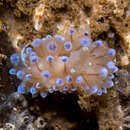pms
nòm ant ël fil


Antiopella cristata, sometimes known by the common name crested aeolis, is a species of nudibranch, a marine gastropod mollusc in the family Janolidae.[2][3]
Previously some authors synonymised Antiopella with Janolus and assigned the genus Janolus to the Janolidae family (see ITIS.gov[4] or AnimalDiversity[5]), others (see Seaslug Forum[6]) to the family of Zephyrinidae, and these were synonymised names of Proctonotidae (see WoRMS).[7] In 2019 an integrated taxonomic study reinstated Antiopella and Janolus as separate genera and placed them in the family Janolidae.[8]
This species is semi-transparent and has an oval-shaped outline. It is cream or light brown in colour, and grows to approximately 7.5 cm in length. The head has oral tentacles that are short.[9]
The lateral cerata are numerous, have a smooth surface and an inflated appearance. The central digestive gland lobe is thin and brown in colour and can be seen through each ceras. These gland lobes divide at the tip of the cerata into numerous terminal branches, distinguishing Janolids from Aeolid nudibranchs. The tips of the cerata are bluish-white and iridescent.[10]
The white surface colouration that is present on the cerata also appears in patches or lines along the bare central dorsum, as well as around the lamellate rhinophores and on the metapodium. The rhinophores are joined together at their bases with a swollen and wrinkled accessory caruncle. Both the rhinophores and median sensory caruncle are somewhat darker in colour than the rest of the body.[9]
Antiopella cristata has been found as far north as Norway down through the British Isles and the French Atlantic coast.[11][9] It has also been recorded in Moroccan waters as well as in the western Mediterranean Sea.[10][12][13][14]
It is found at depths of up to 40 metres, only in calm, clean water, on hard substrata in the sublittoral zone.[9]
Antiopella cristata eats erect bryozoans of the species Alcyonidium gelatinosum, Bicellariella ciliata and in the genus Bugula and Bugulina, such as Bugulina turbinata, Bugula plumosa, Bugula neritina and possibly species in the genus Cellaria.[15][10]
The spawn of this species appear as a light pink or white string forming a wavy, circular pattern. The eggs themselves are contained within packets with transparent patches in between. This gives them the appearance of beads.[10]
A. cristata in the Ligurian Sea (Levanto)
A. cristata on Reteporella grimaldii
Two A. cristata crawl across the bottom. Video clip
Antiopella cristata, sometimes known by the common name crested aeolis, is a species of nudibranch, a marine gastropod mollusc in the family Janolidae.
Antiopelle
L’Antiopelle (Janolus cristatus) est un nudibranche de la famille des proctonotidés[1].
Janolus cristatus est un nudibranche semi-transparent[2]. Cette espèce a une caroncule très haute d'où partent deux lignes blanches vers l'avant et l'arrière[3]. Les ceratas sont très translucides et laissent apparaître les glandes digestives[3]. Les teintes varient de blanc à jaune[3], le sommet des ceratas est bleuté[3]. Des touches de pigments identiques peuvent être trouvées sur le dos, entre les cerata et dans la région de la tête[2].
Les rhinophores lamellés sont particulièrement grands et bien visibles, non rétractiles et sans gaines[2].
Les plus grands individus peuvent atteindre 75 mm[2],[4].
La présence de l'antiopelle est signalée en Atlantique Nord depuis le sud de la Norvège jusqu'au Maroc ainsi que dans la partie occidentale de la Méditerranée[5],[6].
Janolus cristatus est une arminacée carnivore[7]. Elle se nourrit de bryozoaires buissonnants comme Bugula[4].
L’antiopelle est hermaphrodite[7], il peut s’accoupler ou non. En règle générale, il n’y a pas d’autofécondation chez les nudibranches[7]. La reproduction se fera en position tête-bêche, les organes génitaux émergeant sur la droite du corps, derrière la tête[7]. Chacun des partenaires offrira ses gamètes puis pondra des œufs, capsules en forme de perles blanches ou rose pâle, chacune contenant jusqu'à 250 ovules sphériques[8]. La ponte est englobée dans un ruban gélatineux[7] enroulé en forme de cercle ondulé[8]relativement régulier.
La reproduction a lieu d'avril à septembre et en décembre[8].
La première description de Janolus cristatus est le travail de Stefano Delle Chiaje en 1841[9] sous le basionyme de Eolis cristatus delle Chiaje, 1841[10].
Depuis, cette espèce a été décrite plusieurs fois sous des synonymes considérés comme non valides :
Janolus cristatus près d'une anémone Cribrinopsis crassa dans les environs de Marseille.
Sur une « dentelle de Neptune » : Sertella beaniana.
Dans les environs de Marseille.
Antiopelle
L’Antiopelle (Janolus cristatus) est un nudibranche de la famille des proctonotidés.
Antiopella cristata (Delle Chiaje, 1841) è un mollusco nudibranco appartenente alla famiglia Janolidae[1]
Cerata trasparenti a forma di lampadina, in cui sono visibili le estremità dell'apparato digerente, corpo di colore giallo-bianco fino a bruno, talvolta azzurro-blu. Rinofori e cerata dello stesso colore del corpo, fatta eccezione per la parte terminale, blu acceso. Alcuni esemplari, per via dei cerata, possono essere confusi con i nudibranchi del sottordine Aeolidacea, ma a differenza di questi non sono dotati di cnidosacchi contenenti cnidocisti e la posizione dell'ano è differente. Fino a 8 centimetri.
Si nutre di briozoi delle specie Alcyonidium gelatinosum, Bicellariella ciliata, del genere Bugula (Bugula avicularia, Bugula flabellata, Bugula neritina, Bugula turbinata), Bugularia avicularia, del genere Cellaria.[2]
Raro. Reperibile nell'Oceano Atlantico dalla Norvegia al Marocco, nel Mar Mediterraneo occidentale, da pochi metri di profondità ad oltre 30 metri; più comune in presenza di coralligeno.
Antiopella cristata (Delle Chiaje, 1841) è un mollusco nudibranco appartenente alla famiglia Janolidae